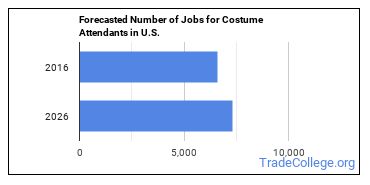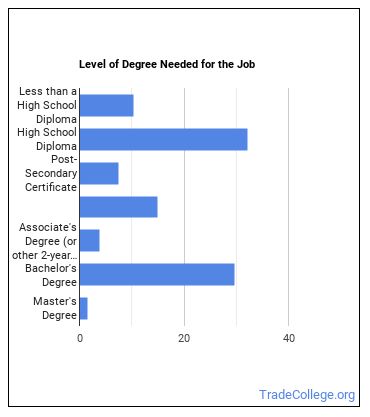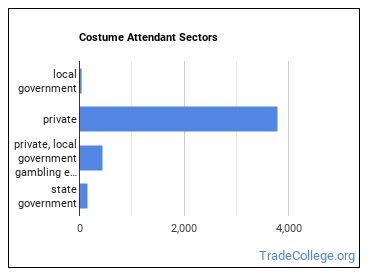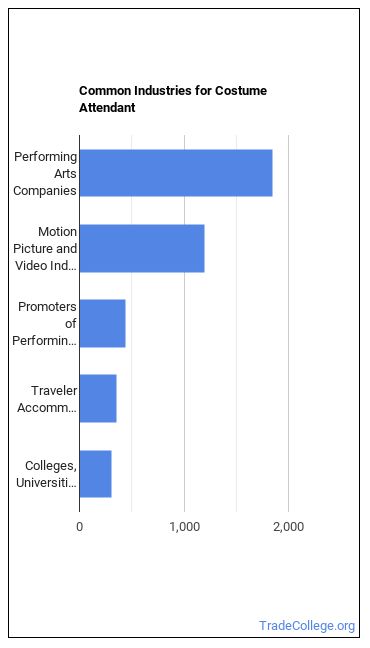What Do Costume Attendant Do?
Career Description Select, fit, and take care of costumes for cast members, and aid entertainers. May assist with multiple costume changes during performances.
Daily Life Of a Costume Attendant
- Inventory stock to determine types or conditions of available costuming.
- Direct the work of wardrobe crews during dress rehearsals or performances.
- Examine costume fit on cast members and sketch or write notes for alterations.
- Check the appearance of costumes on stage or under lights to determine whether desired effects are being achieved.
- Return borrowed or rented items when productions are complete and return other items to storage.
- Collaborate with production designers, costume designers, or other production staff to discuss and execute costume design details.
Featured schools near , edit
Costume Attendant Required Skills
When polled, Costume Attendants say the following skills are most frequently used in their jobs:
Active Listening: Giving full attention to what other people are saying, taking time to understand the points being made, asking questions as appropriate, and not interrupting at inappropriate times.
Speaking: Talking to others to convey information effectively.
Monitoring: Monitoring/Assessing performance of yourself, other individuals, or organizations to make improvements or take corrective action.
Coordination: Adjusting actions in relation to others’ actions.
Social Perceptiveness: Being aware of others’ reactions and understanding why they react as they do.
Reading Comprehension: Understanding written sentences and paragraphs in work related documents.
Related Job Titles
- Costumer Assistant
- Wardrobe Mistress
- Wardrobe Supervisor
- Costume Technician
- Draper
Are There Job Opportunities for Costume Attendants?
There were about 6,600 jobs for Costume Attendant in 2016 (in the United States). New jobs are being produced at a rate of 10.6% which is above the national average. The Bureau of Labor Statistics predicts 700 new jobs for Costume Attendant by 2026. Due to new job openings and attrition, there will be an average of 1,600 job openings in this field each year.

The states with the most job growth for Costume Attendant are South Carolina, Georgia, and Maryland. Watch out if you plan on working in Wisconsin, Tennessee, or Rhode Island. These states have the worst job growth for this type of profession.
Costume Attendant Salary
The typical yearly salary for Costume Attendants is somewhere between $20,430 and $77,630.

Costume Attendants who work in New York, New Mexico, or Kentucky, make the highest salaries.
Below is a list of the median annual salaries for Costume Attendants in different U.S. states.
| State | Annual Mean Salary |
|---|---|
| Alabama | $33,170 |
| Arizona | $35,520 |
| California | $46,140 |
| Colorado | $37,990 |
| Connecticut | $39,920 |
| District of Columbia | $40,670 |
| Florida | $39,500 |
| Georgia | $45,840 |
| Hawaii | $38,580 |
| Illinois | $42,970 |
| Indiana | $41,800 |
| Kentucky | $58,020 |
| Louisiana | $37,250 |
| Massachusetts | $46,380 |
| Michigan | $41,560 |
| Minnesota | $39,950 |
| Missouri | $34,600 |
| Nevada | $50,530 |
| New Jersey | $25,050 |
| New Mexico | $59,970 |
| New York | $68,080 |
| North Carolina | $33,100 |
| Ohio | $35,000 |
| Oregon | $47,990 |
| Pennsylvania | $44,400 |
| South Carolina | $28,890 |
| Tennessee | $40,570 |
| Texas | $36,780 |
| Utah | $27,240 |
| Virginia | $29,420 |
| Washington | $54,390 |
| Wisconsin | $32,520 |
What Tools do Costume Attendants Use?
Although they’re not necessarily needed for all jobs, the following technologies are used by many Costume Attendants:
- Microsoft Excel
- Microsoft Word
- Microsoft Outlook
- Web browser software
- Database software
Becoming a Costume Attendant
Are there Costume Attendants education requirements?

What work experience do I need to become a Costume Attendant?

Who Employs Costume Attendants?

Below are examples of industries where Costume Attendants work:

Related Careers
Those interested in being a Costume Attendant may also be interested in:
Those who work as a Costume Attendant sometimes switch careers to one of these choices:
References:
More about our data sources and methodologies.
Featured Schools
 Request Info
Request Info
|
Southern New Hampshire University You have goals. Southern New Hampshire University can help you get there. Whether you need a bachelor's degree to get into a career or want a master's degree to move up in your current career, SNHU has an online program for you. Find your degree from over 200 online programs. Learn More > |
